
- System of Particles and Rotational Motion Questions and Answers
System of Particles and Rotational Motion Questions and Answers
| 1. Find the centre of mass of a uniform (a) half-disc, (b) quarter-disc. |
| Explanation- let M and R be mass and radius of half disc , mass per unit area of half disc So m = a)the half disc be supposed to be consist of a large number of semicircular ring of mass dm and thickness dr and radii ranging from r=0 to r=R. surface area of semicircular ring of radius r and thickness dr = so mass of the elementary ring dm = dm= if x,y are coordinates of centre of mass of this element, then (x,y)=(0,2r/ ) so x=0 and y =2r/ let xcm and ycm be the coordinates of the centre of mass of the semicircular disc so xcm= Ycm= = 0R = 4R/3 Centre of mass of a uniform quarter disc Mass per unit area of the quarter disc = For half disc along yaxis and xaxis =4R/3 |
| 2. Two discs of moments of inertia I1 and I2 about their respective axes (normal to the disc and passing through the centre), and rotating with angular speed ω1 and w2 are brought into contact face to face with their axes of rotation coincident. (a) Does the law of conservation of angular momentum apply to the situation? why? (b) Find the angular speed of the two-disc system. (c) Calculate the loss in kinetic energy of the system in the process. (d) Account for this loss. |
| Explanation- a) yes the law of conservation of angular momentum can be applied because there is no net external torque on the system of the two discs. External forces gravitation and normal reaction act through the axis of rotation, hence produce no torque. b) by conservation of angular momentum Lf= Li Iw=I1w1+I2w2 So w= c) Kf= Kf= ½ (I1w12+I2w22) Kf-Ki =- 2<0 d) hence there is loss of KE of the system. The loss of kinetic energy is mainly due to work against the friction. |
| 3. A disc of radius R is rotating with an angular speed ωo about a horizontal axis. It is placed on a horizontal table. The coefficient of kinetic friction is µk. (a) What was the velocity of its centre of mass before being brought in contact with the table? (b) What happens to the linear velocity of a point on its rim when placed in contact with the table? (c) What happens to the linear speed of the centre of mass when disc is placed in contact with the table? (d) Which force is responsible for the effects in (b) and (c). (e) What condition should be satisfied for rolling to begin? (f) Calculate the time taken for the rolling to begin. |
| Explanation- before being bought in contact with the table the disc was in pure rotational motion. Hence Vcm=0 b) when the disc is placed in contact with table due to friction centre of mass acquires some linear velocity. c) when the rotating disc is placed in contact with the table due to friction centre of mass acquires some linear velocity. d) friction is responsible for the effects ib b and c e) when rolling starts Vcm=wR f) time period for rolling to begin is t= |
| 4. Two cylindrical hollow drums of radii R and 2R, and of a common height h, are rotating with angular velocities ω (anti-clockwise) and ω (clockwise), respectively. Their axes, fixed are parallel and in a horizontal plane separated by (3 ) R + δ . They are now brought in contact ( 0) δ → . (a) Show the frictional forces just after contact. (b) Identify forces and torques external to the system just after contact. (c) What would be the ratio of final angular velocities when friction ceases |
| Explanation-a) situation as given below b)F’ =F=F’’ where F’ and F’’ are external forces through support. So Fnet=O External torque = F (anticlockwise) c)let w1 and w2 be the final angular velocities of smaller and bigger drum in both clockwise and anticlockwise . finally there will be no friction hence Rw1=2Rw2 so |
Commonly asked questions
A uniform sphere of mass m and radius R is placed on a rough horizontal surface (Fig). The sphere is struck horizontally at a height h from the floor. Match the following:
(a) h = R/2 (i) Sphere rolls without slipping with a constant velocity and no loss of energy.
(b) h = R (ii) Sphere spins clockwise, loses energy by friction.
(c) h = 3R/2 (iii) Sphere spins anti-clockwise, loses energy by friction.
(d) h = 7R/5 (iv) Sphere has only a translational motion, looses energy by friction.
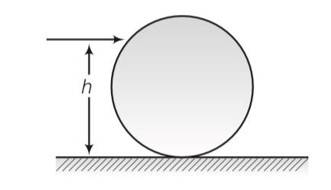
This is a short answer type question as classified in NCERT Exemplar
Consider a fig in which m is mass of sphere and R is the radius having h height above the floor
The sphere will roll without slipping when w=v/r where v is linear velocity and w is angular velocity .
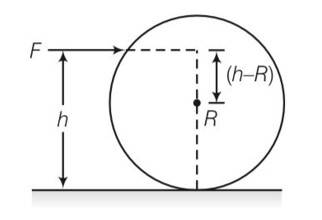
By conservation of momentum
mv (h-R)=Iw=2/5mR2 (v/R)
mv (h-R)=2/5mvR
h-R=2/5R
so h = 7/5R .d sphere will roll here so no loss of energy.
Torque = F (h-R)
For torque=0 h=R sphere will have only translational motion. It would lose energy by friction.
b
the sphere will spin clockwise when t>0 so h>R
so c and a
The density of a non-uniform rod of length 1m is given by ρ(x) = a(1+bx2) where a and b are constants and o ≤x ≤1. The centre of mass of the rod will be at
(a)
(b)
(c)
(d)
This is a multiple choice type question as classified in NCERT Exemplar
(a) Density is given as ρ (x) = a (1+bx2)
Where a and b are constant and 0
Let b=0 ρ (x) = a= constant
Hence COM will be at x =0.5m
Putting b=0 ain above option only a gives this answer.
We should not check options by putting a=0 because for a=0
With reference to Fig. of a cube of edge a and mass m, state whether the following are true or false. (O is the centre of the cube.)
(a) The moment of inertia of cube about z-axis is Iz = Ix + Iy
(b) The moment of inertia of cube about z′ is Iz =Iz +ma2/2
(c) The moment of inertia of cube about z″ is Iz+ma2/2 (d) Ix = Iy
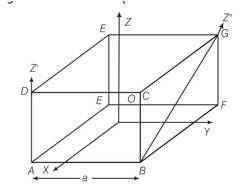
This is a multiple choice type question as classified in NCERT Exemplar
a, b, d
a) according to the perpendicular axes theorem statement 1 is wrong
b) As z’|z so distance between them = a
So according to parallel axes theorem Iz’=Iz+m (a/ )2= Iz+ma2/2
Hence b is true
c) z’ is not parallel to z hence Parallel axes does not applied so statement is false
d) as x and y axes are symmetrical . hence Ix=Iy so d is true
d) as x and y axes are symmetrical . hence Ix=Iy so d is true
A uniform square plate S (side c) and a uniform rectangular plate R (sides b, a) have identical areas and masses. Show that
(i) IxR/IxS<1 (ii) IyR/IyS>1 (iii) IzR/IzS>1

This is a long answer type question as classified in NCERT Exemplar
area of square = area of rectangular plate
C2=a b
(a) here bxR
(b) here a>c so IyR>IyS
(c) IzR-IzS +2ab= (a-b)2
(IzR-IzS)>0
The centre of gravity of a body on the earth coincides with its centre of mass for a ‘small’ object whereas for an ‘extended’ object it may not. What is the qualitative meaning of ‘small’ and ‘extended’ in this regard ? For which of the following the two coincides? A building, a pond, a lake, a mountain?
This is a short answer type question as classified in NCERT Exemplar
When the vertical height of the objects is very small as compared to the earth's radius we call the objects small, otherwise it is extended. Building and ponds are small objects and deep lake and ocean are examples of extended objects.
Why does a solid sphere have smaller moment of inertia than a hollow cylinder of same mass and radius, about an axis passing through their axes of symmetry?
This is a short answer type question as classified in NCERT Exemplar
The moment of inertia of the object I = r2 [sum of moment of inertia of each constituents particles]
All the mass in a cylinder lies at a distance R from the axis of symmetry but most of the mass of a solid sphere lies at a smaller distance than R.
The variation of angular position θ , of a point on a rotating rigid body, with time t is shown in Fig. Is the body rotating clock-wise or anti-clockwise?
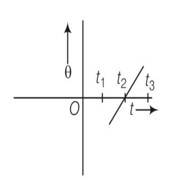
This is a short answer type question as classified in NCERT Exemplar
As the slope of graph is positive and positive slope indicates anti clockwise rotation which is traditionally taken as positive.
A uniform cube of mass m and side a is placed on a frictionless horizontal surface. A vertical force F is applied to the edge as shown in Fig. Match the following (most appropriate choice):
(a) mg/4 < F mg < /2 (i) Cube will move up.
(b) F > mg/2 (ii) Cube will not exhibit motion.
(c) F > mg (iii) Cube will begin to rotate and slip at A.
(d) F = mg/4 (iv) Normal reaction effectively at a/3 from A, no motion.
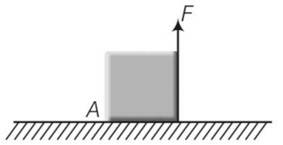
This is a short answer type question as classified in NCERT Exemplar
Moment of force 1= F (a)….anticlockwise
Moment of weight mg 2=mg (a/2)……. (clockwise)
Cube will not exhibit motion then 1 2
F=mg/2
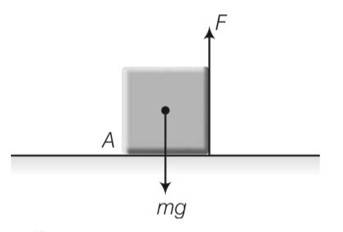
Cube will rotate when 1 2
F>mg/2
At a/3 from point A then
mg
when F=mg/4 which is less then mg/3 there will be no motion.
The vector sum of a system of non-collinear forces acting on a rigid body is given to be non-zero. If the vector sum of all the torques due to the system of forces about a certain point is found to be zero, does this mean that it is necessarily zero about any arbitrary point?
This is a short answer type question as classified in NCERT Exemplar
no
The sum of torques about a certain point O
The sum of torques about any other O
The sum of torques about any other point O’
Here the second term need not vanish.
Sum of all torques about any point is zero.
A door is hinged at one end and is free to rotate about a vertical axis. Does its weight cause any torque about this axis? Give reason for your answer.
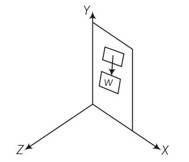
This is a short answer type question as classified in NCERT Exemplar
Where weight of the door acts along negative y axis
A force can produce torque only along a direction normal to itself as . So when the door is in the xy plane the torque produced by gravity can only along z direction. Never about an axis passing through y direction. Hence the weight will not produce any torque.
For which of the following does the centre of mass lie outside the body ?
(a) A pencil
(b) A shotput
(c) A dice
(d) A bangle
This is a multiple choice type question as classified in NCERT Exemplar
(d) The bangle is in the form of ring. The centre of mass lies at the centre which is outside the body so C.O.M of bangle lies outside the circle.
Figure shows two identical particles 1 and 2, each of mass m, moving in opposite directions with same speed v along parallel lines. At a particular instant, r1 and r2 are their respective position vectors drawn from point A which is in the plane of the parallel lines.
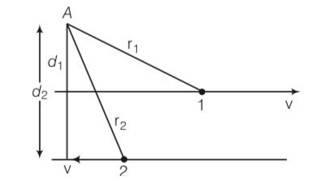
Choose the correct options:
(a) Angular momentum l1 of particle 1 about A is I = mvd1
(b) Angular momentum l2 of particle 2 about A is l2= mvr2
(c) Total angular momentum of the system about A is l= mv(r1+r2)
(d) Total angular momentum of the system about A is l = mv(d2-d1)⊗ represents a unit vector coming out of the page. ⊗ represents a unit vector going into the page.
This is a multiple choice type question as classified in NCERT Exemplar
(a), (b)As we know L= r p where r is position vector and p is the linear momentum . the direction of L is perpendicular to both r and p by right hand rule.
For particle 1
I1=r1 mv is out of the plane of the paper and perpendicular to r1 and p . similarly I2=r2 m (-v) is into the plane of the paper and perpendicular to r2 and -p.
Hence total angular momentum
L= L1+L2= I1=r1 mv+ (r2 m (-v)
L= mvd1-mvd2 as d2>d1
So total angular momentum will be inwards so I = l = mv (d2-d1)⊗
L= mvd1-mvd2 as d2>d1
So total angular momentum will be inwards so I = l = mv (d2-d1)?
Find the centre of mass of a uniform (a) half-disc, (b) quarter-disc.
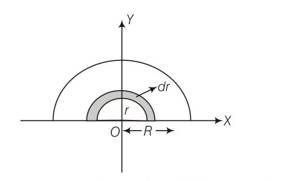
This is a long answer type question as classified in NCERT Exemplar
let M and R be mass and radius of half disc , mass per unit area of half disc
So m =
(a) the half disc be supposed to be consist of a large number of semicircular ring of mass dm and thickness dr and radii ranging from r=0 to r=R.
surface area of semicircular ring of radius r and thickness dr =
so mass of the elementary ring dm =
dm=
if x,y are coordinates of centre of mass of this element,
then (x,y)=(0,2r/ )
so x=0 and y =2r/
let xcm and ycm be the coordinates of the centre of mass of the semicircular disc
so xcm=
Ycm=
= 0R
= 4R/3
Centre of mass of a uniform quarter disc
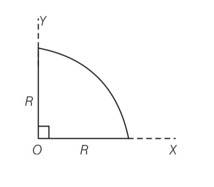
Mass per unit area of the quarter disc =
For half disc along yaxis and xaxis =4R/3
Two discs of moments of inertia I1 and I2 about their respective axes (normal to the disc and passing through the centre), and rotating with angular speed ω1 and w2 are brought into contact face to face with their axes of rotation coincident.
(a) Does the law of conservation of angular momentum apply to the situation? why?
(b) Find the angular speed of the two-disc system.
(c) Calculate the loss in kinetic energy of the system in the process.
(d) Account for this loss.
This is a long answer type question as classified in NCERT Exemplar
(a) yes the law of conservation of angular momentum can be applied because there is no net external torque on the system of the two discs.
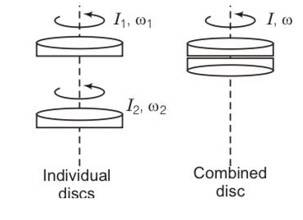
External forces gravitation and normal reaction act through the axis of rotation, hence produce no torque.
(b) by conservation of angular momentum
Lf= Li
Iw=I1w1+I2w2
So w=
(c) Kf=
Kf= ½ (I1w12+I2w22)
Kf-Ki =- 2<0
(d) hence there is loss of KE of the system. The loss of kinetic energy is mainly due to work against the friction.
A disc of radius R is rotating with an angular speed ωo about a horizontal axis. It is placed on a horizontal table. The coefficient of kinetic friction is µk.
(a) What was the velocity of its centre of mass before being brought in contact with the table?
(b) What happens to the linear velocity of a point on its rim when placed in contact with the table? (c) What happens to the linear speed of the centre of mass when disc is placed in contact with the table?
(d) Which force is responsible for the effects in (b) and (c).
(e) What condition should be satisfied for rolling to begin?
(f) Calculate the time taken for the rolling to begin.
This is a long answer type question as classified in NCERT Exemplar
(a) Before being bought in contact with the table the disc was in pure rotational motion. Hence Vcm=0
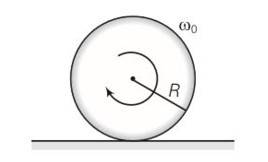
(b) when the disc is placed in contact with table due to friction centre of mass acquires some linear velocity.
(c) when the rotating disc is placed in contact with the table due to friction centre of mass acquires some linear velocity.
(d) friction is responsible for the effects ib b and c
(e) when rolling starts Vcm=wR
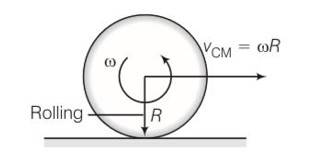
(f) time period for rolling to begin is t=
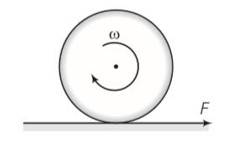
Two cylindrical hollow drums of radii R and 2R, and of a common height h, are rotating with angular velocities ω (anti-clockwise) and ω (clockwise), respectively. Their axes, fixed are parallel and in a horizontal plane separated by (3 ) R + δ . They are now brought in contact ( 0) δ → .
(a) Show the frictional forces just after contact.
(b) Identify forces and torques external to the system just after contact.
(c) What would be the ratio of final angular velocities when friction ceases
This is a long answer type question as classified in NCERT Exemplar
(a) Situation as given below

(b) F’ =F=F’’ where F’ and F’’ are external forces through support.
So Fnet=O

External torque = F (anticlockwise)
(c) Let w1 and w2 be the final angular velocities of smaller and bigger drum in both clockwise and anticlockwise . finally there will be no friction
hence Rw1=2Rw2
so
A uniform disc of radius R, is resting on a table on its rim. The coefficient of friction between disc and table is µ (Fig). Now the disc is pulled with a force F as shown in the figure. What is the maximum value of F for which the disc rolls without slipping ?
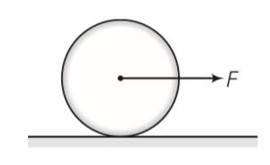
This is a long answer type question as classified in NCERT Exemplar
Frictional force f is acting in the opposite direction of F . let the acceleration of centre of mass of disc be a then
F-f=Ma where M is the mass of the disc
fR= (1/2 MR2)
so fR= (1/2MR2) (a/R)
Ma=2f
From the above equation
F = F/3
F< =
f/3 <
F=3
A wheel in uniform motion about an axis passing through its centre and perpendicular to its plane is considered to be in mechanical (translational plus rotational) equilibrium because no net external force or torque is required to sustain its motion. However, the particles that constitute the wheel do experience a centripetal acceleration directed towards the centre. How do you reconcile this fact with the wheel being in equilibrium? How would you set a half-wheel into uniform motion about an axis passing through the centre of mass of the wheel and perpendicular to its plane? Will you require external forces to sustain the motion?
This is a short answer type question as classified in NCERT Exemplar
Wheel is a rigid body. The particles that constitute the wheel do experience a centripetal acceleration directed towards the centre. This acceleration arises due to internal elastic forces which cancel out in pairs.
In a half wheel the distribution of mass about its centre of mass is not symmetrical, therefore the direction of angular momentum of the wheel does not coincide with the direction of its angular velocity. Hence an external torque is required to maintain the motion of the wheel.
(n-1) equal point masses each of mass m are placed at the vertices of a regular n-polygon. The vacant vertex has a position vector a with respect to the centre of the polygon. Find the position vector of centre of mass.
This is a short answer type question as classified in NCERT Exemplar
Let b be the position vector of the centre of mass of a regular n-polygon.
(n-1) equal point masses are placed at (n-1) vertices of the regular n polygon, therefore for its centre of mass
rCM=
(n-1)mb+ma=0
B=-
Which of the following points is the likely position of the centre of mass of the system shown in Fig.?
(a) A
(b) B
(c) C
(d) D

This is a multiple choice type question as classified in NCERT Exemplar
(c) Centre of mass lies towards the part of system of higher mass. In the above diagram the lower part is heavier bigger mass is downward . So COM lies below diameter.
A particle of mass m is moving in yz-plane with a uniform velocity v with its trajectory running parallel to +ve y-axis and intersecting z-axis at z = a . The change in its angular momentum about the origin as it bounces elastically from a wall at y = constant is:
(a) mva êx
(b) 2mva êx
(c) ymv êx
(d) 2ymv êx
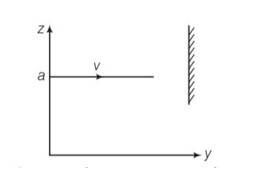
This is a multiple choice type question as classified in NCERT Exemplar
(b) The initial velocity is vi = vey and after reflecting from the wall the final velocity is vf= -vey. The trajectory is described as r= yey+aez.
hence the change in momentum is r .
When a disc rotates with uniform angular velocity, which of the following is not true?
(a) The sense of rotation remains same.
(b) The orientation of the axis of rotation remains same.
(c) The speed of rotation is non-zero and remains same.
(d) The angular acceleration is non-zero and remains same.
This is a multiple choice type question as classified in NCERT Exemplar
(d) we know that angular acceleration , given w=constant
where w is the angular velocity of the disc
Hence angular acceleration is zero.
A uniform square plate has a small piece Q of an irregular shape removed and glued to the centre of the plate leaving a hole behind (Fig. 7.3). The moment of inertia about the z-axis is then
(a) Increased
(b) Decreased
(c) The same
(d) Changed in unpredicted manner.
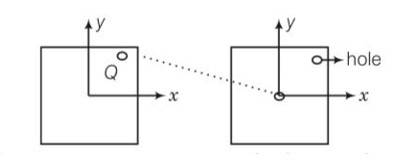
This is a multiple choice type question as classified in NCERT Exemplar
(b) When the small piece Q is removed and glued to the centre of the plate . the mass closer to the z axis . hence moment of inertia decreases.
In problem 7.5, the CM of the plate is now in the following quadrant of x-y plane,
(a) I
(b) II
(c) III
(d) IV
This is a multiple choice type question as classified in NCERT Exemplar
(c) First the centre of mass of the system was on the dotted line and was shifted towards Q from the centre. When mass is removed it will be on the same line but shifed away from the centre and below 3rd quadrant.
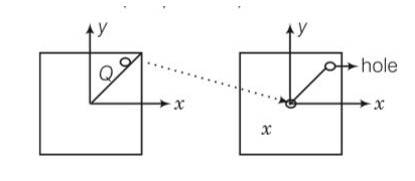
A Merry-go-round, made of a ring-like platform of radius R and mass M, is revolving with angular speed ω . A person of mass M is standing on it. At one instant, the person jumps off the round, radially away from the centre of the round (as seen from the round). The speed of the round afterwards is
(a) 2ω
(b) ω
(c) 2 ω
(d) 0
This is a multiple choice type question as classified in NCERT Exemplar
(a) As no external torque acts on the system, angular momentum should be conserved hence Iw=constant
Where I is moment of inertia of the system and w is the angular velocity of the system.
So I1w1= I2w2
Where w1 and w2 are angular velocities before and after jumping.
Iw=
w2=2w
Choose the correct alternatives:
(a) For a general rotational motion, angular momentum L and angular velocity ω need not be parallel.
(b) For a rotational motion about a fixed axis, angular momentum L and angular velocity ω are always parallel.
(c) For a general translational motion , momentum p and velocity v are always parallel.
(d) For a general translational motion, acceleration a and velocity v are always parallel.
This is a multiple choice type question as classified in NCERT Exemplar
(a), (c) For general rotational motion where axis of rotation is not symmetric . angular momentum L and angular velocity w need not be parallel. For general translational motion momentum p=mv hence p and v are always parallel.
The net external torque on a system of particles about an axis is zero. Which of the following are compatible with it ?
(a) The forces may be acting radially from a point on the axis.
(b) The forces may be acting on the axis of rotation.
(c) The forces may be acting parallel to the axis of rotation.
(d) The torque caused by some forces may be equal and opposite to that caused by other forces
This is a multiple choice type question as classified in NCERT Exemplar
a, b, c, d
As we know torque = r F = rFsin
a) when forces act radially angle =0 hence torque =0
b) when forces are acting on the axis of rotation r=0 torque=0
c) when forces acting parallel to the axis of rotation angle =0 so torque =0
d) when torque by forces are equal and opposite torque net = t1-t2=0
Figure 7.5 shows a lamina in x-y plane. Two axes z and z′ pass perpendicular to its plane. A force F acts in the plane of lamina at point P as shown. Which of the following are true? (The point P is closer to z′-axis than the z-axis.)
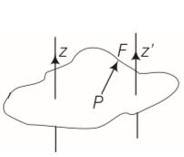
(a) Torque τ caused by F about z axis is along ˆ -k.
(b) Torque τ′ caused by F about z′ axis is along ˆ -k.
(c) Torque τ caused by F about z axis is greater in magnitude than that about z axis.
(d) Total torque is given be τ = τ + τ′.
This is a multiple choice type question as classified in NCERT Exemplar
b, c
a) When r>r’
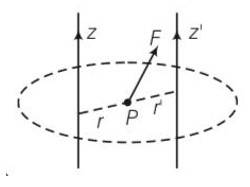
Torque about z-axis t=r F
b) t’=r’ which is along negative z axis
c) tz=Fr = magnitude of torque about z axis where r is perpendicular between F and z axis so torque along positive z axis is greater than negative z axis.
d) We are always calculating resultant torque about common axis. Hence total torque not equal to combination of torque along both axis of z, because they are not on common axis.
Physics NCERT Exemplar Solutions Class 11th Chapter Seven Exam
